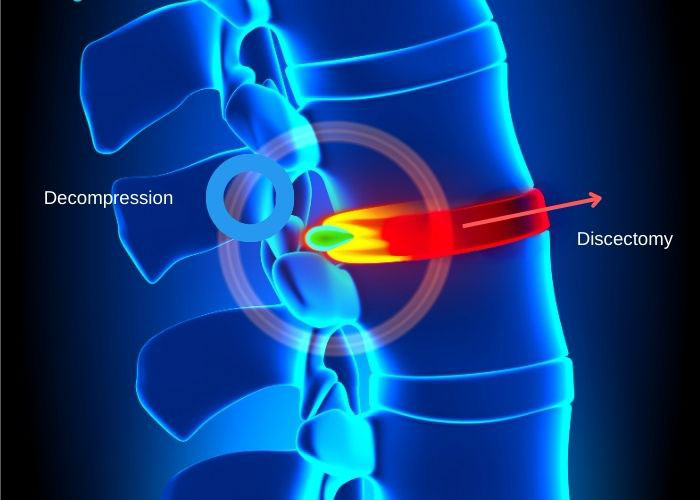Thoracic Discectomy and Decompression Surgeon
If you’re struggling with chronic back pain, experiencing weakness or numbness in your limbs, or having difficulty walking or standing, don’t wait any longer. Dr. Andre M. Samuel, an orthopedic spine surgeon serving Clear Lake, Houston, and Sugar Land, TX, specializes in thoracic discectomy and decompression surgery, offering the expert care you need. Contact Dr. Samuel’s team today!

What are thoracic discectomy and decompression?
These two surgical procedures may seem similar, but they relieve pressure on the spinal cord differently. In a thoracic discectomy, the surgeon removes a herniated disc from the mid-back to ease pressure. On the other hand, decompression involves removing a small portion of the lamina – the bone covering the spinal cord – to achieve the same goal. Decompression is often the choice for those with spinal stenosis, where the narrowing of the spinal canal causes chronic pain and neurological issues.
Both procedures help to improve mobility and alleviate discomfort but are not commonly performed by most spine surgeons. Doctor Andre M. Samuel, orthopedic spine surgeon, has advanced training and unique expertise in treating thoracic spinal stenosis and thoracic disc herniations frequently, often receiving referrals from other spine surgeons in the Clear Lake, Houston and Sugar Land areas.

Who is a candidate for thoracic discectomy or decompression?
The ideal candidates for thoracic discectomy or decompression surgery are those who haven’t found relief through conservative treatments like physical therapy or medication. If a herniated disc affects a patient’s quality of life, they may also be a strong candidate. Dr. Samuel may recommend one of these procedures for patients experiencing symptoms such as:
- Chronic leg or foot pain
- Weakness or numbness in the limbs
- Difficulty walking or standing
- Loss of bladder or bowel function
It’s important to consult with an expert surgeon like Dr. Samuel to determine if surgical intervention is necessary to alleviate spinal pressure. During the consultation, Dr. Samuel conducts a thorough examination, including reviewing imaging results such as MRIs or CT scans, to diagnose the issue. Dr. Samuel and his team explain the pros and cons of the operations to each patient before any surgery is scheduled.
How are thoracic discectomy and decompression performed?
For both, the patient is put to sleep under general anesthesia. In a thoracic discectomy, Dr. Samuel makes an incision in the mid-back and gently moves the muscles and tissues aside. Once the spine is exposed, Dr. Samuel may use imaging guidance such as a fluoroscopy to locate the herniated disc before its removal. Once removed, the muscles are put back into place and sutures are used to close the incision.
Decompression surgery follows a similar initial approach, but instead of removing a herniated disc, Dr. Samuel removes a small portion of the lamina – which covers the spinal cord. This increases the space around the spinal cord, reducing pressure and pain. Once the procedure is complete, the incision is also closed using sutures.
Post-surgery, patients are monitored in recovery to make sure there are no complications.
How long does it take to recover from thoracic discectomy or decompression?
Depending on the extent of the surgery, a patient may spend a day or two in the hospital before going home. Walking is encouraged shortly after surgery and helps promote healing. It also helps reduce the risk of complications like blood clots.
The patient should be able to return to work four to six weeks after surgery, about the same time Dr. Samuel will recommend physical therapy. A full recovery takes about three to six months. As with any surgery, healing times vary and it is important to follow all post-surgical instructions for the best outcome.



